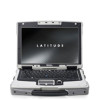Dell Latitude D630 XFR User's Guide - Page 69
Using the Hardware Troubleshooter Tool, Restoring Your Operating System
 |
View all Dell Latitude D630 XFR manuals
Add to My Manuals
Save this manual to your list of manuals |
Page 69 highlights
4. At the welcome screen, click Next and wait for the media to complete the hardware scan. 5. To detect other drivers and utilities, under Search Criteria, select the appropriate categories from the System Model, Operating System, and Topic drop-down menus. A link or links appear(s) for the specific drivers and utilities used by your computer. 6. Click the link of a specific driver or utility to display information about the driver or utility that you want to install. 7. Click the Install button (if present) to begin installing the driver or utility. At the welcome screen, follow the screen prompts to complete the installation. If no Install button is present, automatic installation is not an option. For installation instructions, either see the appropriate instructions in the following subsections, or click Extract, follow the extracting instructions, and then read the readme file. If instructed to navigate to the driver files, click the media directory on the driver information window to display the files associated with the driver. Manually Reinstalling Drivers NOTE: After extracting the driver files to your hard drive as described in the previous section, reinstall the drivers. Microsoft Windows XP 1. Click Start→ My Computer→ Properties→ Hardware→ Device Manager. 2. Double-click the type of device for which you are installing the driver (for example, Audio or Video). 3. Double-click the name of the device for which you are installing the driver. 4. Click the Driver tab→ Update Driver. 5. Click Install from a list or specific location (Advanced)→ Next. 6. Click Browse and browse to the location to which you previously copied the driver files. 7. When the name of the appropriate driver appears, click Next. 8. Click Finish and restart your computer. Microsoft Windows Vista 1. Click the Windows Vista start button, 2. Click Properties→ Device Manager. , and right-click Computer. NOTE: The User Account Control window may appear. If you are an administrator on the computer, click Continue; otherwise, contact your administrator to enter the Device Manager. 3. Double-click the type of device for which you are installing the driver (for example, Audio or Video). 4. Double-click the name of the device for which you are installing the driver. 5. Click the Driver tab→ Update Driver→ Browse my computer for driver software. 6. Click Browse and browse to the location to which you previously copied the driver files. 7. When the name of the appropriate driver appears, click the name of the driver→ OK→ Next. 8. Click Finish and restart your computer. 13.2 Using the Hardware Troubleshooter Tool If a device is either not detected during the operating system setup or is detected but incorrectly configured, you can use the Hardware Troubleshooter to resolve the incompatibility. Microsoft Windows XP 1. Click Start→ Help and Support. 2. Type 'hardware troubleshooter' in the search field and press to start the search. 3. In the Fix a Problem section, click Hardware Troubleshooter. 4. In the Hardware Troubleshooter list, select the option that best describes the problem and click Next to follow the remaining troubleshooting steps. Microsoft Windows Vista 1. Click the Windows Vista start button, , and click Help and Support. 2. Type hardware troubleshooter in the search field and press to start the search. 3. In the search results, select the option that best describes the problem and follow the remaining troubleshooting steps. 13.3 Restoring Your Operating System You can restore your operating system in the following ways Microsoft Windows XP System Restore and Microsoft Windows Vista System Restore return your computer to an earlier operating state without affecting data files. Use System Restore as the first solution for restoring your















